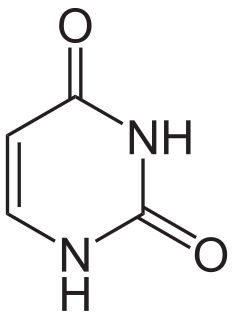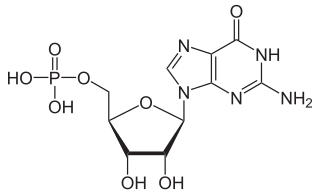
Cyclic adenosine monophosphate is a second messenger important in many biological processes. cAMP is a derivative of adenosine triphosphate (ATP) and used for intracellular signal transduction in many different organisms, conveying the cAMP-dependent pathway. It should not be confused with 5'-AMP-activated protein kinase.

Nucleotides are molecules consisting of a nucleoside and a phosphate group. They are the basic building blocks of DNA and RNA.

Uracil is one of the four nucleobases in the nucleic acid of RNA that are represented by the letters A, G, C and U. The others are adenine (A), cytosine (C), and guanine (G). In RNA, uracil binds to adenine via two hydrogen bonds. In DNA, the uracil nucleobase is replaced by thymine. Uracil is a demethylated form of thymine.
Deoxyribose, or more precisely 2-deoxyribose, is a monosaccharide with idealized formula H−(C=O)−(CH2)−(CHOH)3−H. Its name indicates that it is a deoxy sugar, meaning that it is derived from the sugar ribose by loss of an oxygen atom. Since the pentose sugars arabinose and ribose only differ by the stereochemistry at C2′, 2-deoxyribose and 2-deoxyarabinose are equivalent, although the latter term is rarely used because ribose, not arabinose, is the precursor to deoxyribose.

Adenosine monophosphate (AMP), also known as 5'-adenylic acid, is a nucleotide. AMP consists of a phosphate group, the sugar ribose, and the nucleobase adenine; it is an ester of phosphoric acid and the nucleoside adenosine. As a substituent it takes the form of the prefix adenylyl-.

A cyclic nucleotide (cNMP) is a single-phosphate nucleotide with a cyclic bond arrangement between the sugar and phosphate groups. Like other nucleotides, cyclic nucleotides are composed of three functional groups: a sugar, a nitrogenous base, and a single phosphate group. As can be seen in the cyclic adenosine monophosphate (cAMP) and cyclic guanosine monophosphate (cGMP) images, the 'cyclic' portion consists of two bonds between the phosphate group and the 3' and 5' hydroxyl groups of the sugar, very often a ribose.

In biochemistry, a ribonucleotide is a nucleotide containing ribose as its pentose component. It is considered a molecular precursor of nucleic acids. Nucleotides are the basic building blocks of DNA and RNA. The monomer itself from ribonucleotides forms the basic building blocks for RNA. However, the reduction of ribonucleotide, by enzyme ribonucleotide reductase (RNR), forms deoxyribonucleotide, which is the essential building block for DNA. There are several differences between DNA deoxyribonucleotides and RNA ribonucleotides. Successive nucleotides are linked together via phosphodiester bonds by 3'-5'.
A transcriptional activator is a protein that increases gene transcription of a gene or set of genes. Most activators are DNA-binding proteins that bind to enhancers or promoter-proximal elements.

Guanosine monophosphate (GMP), also known as 5'-guanidylic acid or guanylic acid, is a nucleotide that is used as a monomer in RNA. It is an ester of phosphoric acid with the nucleoside guanosine. GMP consists of the phosphate group, the pentose sugar ribose, and the nucleobase guanine; hence it is a ribonucleoside monophosphate. Guanosine monophosphate is commercially produced by microbial fermentation. It is known as E number reference E626.

3'5'-cyclic nucleotide phosphodiesterases are a family of phosphodiesterases. Generally, these enzymes hydrolyze some nucleoside 3',5'-cyclic phosphate to some nucleoside 5'-phosphate thus controlling the cellular levels of the cyclic second messengers and the rates of their degradation. Some examples of nucleoside 3',5'-cyclic phosphate include:

Nucleic acid metabolism is the process by which nucleic acids are synthesized and degraded. Nucleic acids are polymers of nucleotides. Nucleotide synthesis is an anabolic mechanism generally involving the chemical reaction of phosphate, pentose sugar, and a nitrogenous base. Destruction of nucleic acid is a catabolic reaction. Additionally, parts of the nucleotides or nucleobases can be salvaged to recreate new nucleotides. Both synthesis and degradation reactions require enzymes to facilitate the event. Defects or deficiencies in these enzymes can lead to a variety of diseases.

Deoxyadenosine monophosphate (dAMP), also known as deoxyadenylic acid or deoxyadenylate in its conjugate acid and conjugate base forms, respectively, is a derivative of the common nucleic acid AMP, or adenosine monophosphate, in which the -OH (hydroxyl) group on the 2' carbon on the nucleotide's pentose has been reduced to just a hydrogen atom. Deoxyadenosine monophosphate is abbreviated dAMP. It is a monomer used in DNA.

Deoxycytidine monophosphate (dCMP), also known as deoxycytidylic acid or deoxycytidylate in its conjugate acid and conjugate base forms, respectively, is a deoxynucleotide, and one of the four monomers that make up DNA. In a DNA double helix, it will base pair with deoxyguanosine monophosphate.

8-Bromoguanosine 3',5'-cyclic monophosphate is a brominated derivative of cyclic guanosine monophosphate (cGMP). It acts as an activator of cGMP-dependent protein kinases.

8-Bromoadenosine 3',5'-cyclic adenosine monophosphate (8-Br-cAMP) is a brominated derivative of cyclic adenosine monophosphate (cAMP). 8-Br-cAMP is an activator of cyclic AMP-dependent protein kinase, and it is long-acting because it is resistant to degradation by cyclic AMP phosphodiesterase.
Zhijian "James" Chen is a Chinese-American biochemist and Professor in the Department of Molecular Biology at University of Texas Southwestern Medical Center. He is best known for his discovery of mechanisms by which nucleic acids trigger innate and autoimmune responses from the interior of a cell, work for which he received the 2019 Breakthrough Prize in Life Sciences.

Cyclic guanosine monophosphate–adenosine monophosphate is the first cyclic di-nucleotide found in metazoa. In mammalian cells, cGAMP is synthesized by cyclic GMP-AMP synthase (cGAS) from ATP and GTP upon cytosolic DNA stimulation. cGAMP produced by cGAS contains mixed phosphodiester linkages, with one between 2'-OH of GMP and 5'-phosphate of AMP and the other between 3'-OH of AMP and 5'-phosphate of GMP.

Stimulator of interferon genes (STING), also known as transmembrane protein 173 (TMEM173) and MPYS/MITA/ERIS is a protein that in humans is encoded by the TMEM173 gene.
Cyclic di-AMP is a second messenger used in signal transduction in bacteria.













